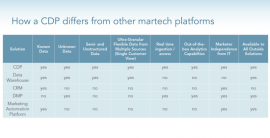Expert tips to consider before buying a CDP for your martech stack

With organizations wrestling more and more with the abundance of data that marketing channels are yielding, it is no wonder that managers of martech stacks are weighing the pros and cons of customer data platforms.
Generally, these platforms are designed to collect customer data from all sources, normalize that data and build unique unified profiles for each individual customer. But before jumping in there are a few things to make sure you consider as you begin the purchase process.
Look in the mirror
Before you even start gathering up information on solutions to improve your data management, make sure you understand your capabilities as they exist today, said Craig Howard, VP of technology and chief solution architect at Merkle, at a MarTech session on CDP purchasing Tuesday.
“What you need to get out of a platform is oftentimes a differentiator for organizations when they’re trying to make a choice. Some platforms will kind of expect you to bring nice clean data to them. Other platforms will give you a lot of really powerful tooling to help you with the data quality problem within the platform.”
Watch the Session: The Evolution of Customer Data Platforms and How to Evaluate Them
Next, make sure you have a solid sense of your existing architecture, your existing resources and team, and the sophistication of both. On one hand, if you give a team features that they will not be able to use then they will not take full advantage of the platform.
“And if you don’t give them enough features, they will be equally unhappy,” said David Raab, CEO of the CDP Institute.
Do the research
Now that you’ve taken a good look at your capabilities and need, it’s time to start making your vendor list, which can be done using a variety of resources like the Martech Intelligence Report that was at the center of Tuesday’s MarTech session. Get ready to watch a ton of webinars, read more than a handful white papers and to dig through spec sheets on the platforms.
But to make that more effective, think beyond capabilities and look for info on solutions.
“Look at what they’re solving for within those case studies,” said Howard. “Understand their legacy. Understand the industries they have history with to really get a sense of what has a similar approach to solving the problems that I’m looking to solve myself.”
Making demos count
Once you’ve narrowed down your vendor list, it’s time to move into the demo process. But to truly get the most of the experience there are a few things to consider.
“Giving more than one demo is really important,” said Howard. “The first round ends up being more of an education process, I’d say, where you’re understanding the variety that’s out there as you talk to different vendors and then you get a sense of what’s maybe the best flavor for your organization. And then you have a little better idea of what to look for in subsequent demos, and you have more ability to ask difficult questions and probe into certain capabilities that are really important to you.”
Also important: make sure the demo caters to your specific use cases.
“It doesn’t matter if you have like a really slick digitalization for data. If my real problem is identity matching then I’m going to see your identity matching feature,” said Raab. “It’s really important that you as the buyer take control of that, because your time is limited. Make sure that you are seeing the thing you need to see and not just the things they want to show you.”
This story first appeared on MarTech Today.
The post Expert tips to consider before buying a CDP for your martech stack appeared first on Marketing Land.
From our sponsors: Expert tips to consider before buying a CDP for your martech stack




